I found this idea and decided to try it out.
Each student created a little notebook that they decorated and I placed an inquiry letter inside. This letter outlines 4 easy steps on how to start your own inquiry over the summer. We also discussed ideas, how to use the book, and places they may want to store it so it does not get lost!
I asked that they share their discoveries with us in September!
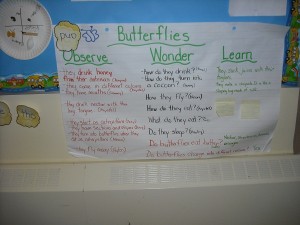 Our Inquiry on Growth and Change integrated the discovery of Butterflies.
Our Inquiry on Growth and Change integrated the discovery of Butterflies.
We created OWL (KLW) chart to see what the children already knew and had previously observed about butterflies.
We started asking questions about butterflies and observed the caterpillars in their jars and later they began forming their chrysalises. It was a great time to review questioning and how to formulate one. Once we discussed and read about butterflies the children began to develop deeper questions. For example; I wonder if butterflies can fly? to questions like… I wonder how they know when their enemies are coming? We also reviewed diagrams and how to label parts.
We created a chart to record how long it takes (passage of time) for the butterflies to change; from caterpillar to chrysalis, and chrysalis to butterfly. Some did not change all at the same time, and we compared our observations of change to what had been noted in videos and readings.
Students documented their observations in their journals.
We created an “I wonder” binder for the centre where children freely recorded their questions.
The children, along side the educators researched our questions through books, internet, and through short YouTube videos.
At the craft centre, children had the option to show their learning through recreating the life cycle with natural materials found outside to represent the different stages–real leaves, sticks, tree seeds for caterpillar bodies!
In the end, the children communicated to us their new learning through a written response and oral discussion. We released the butterflies at the 3 week period and we read an aboriginal legend about whispering a wish when you release the butterfly.
The Ontario Early Years Policy Framework is available on the Ministry of Education Website in pdf format. Below is a description from the website indicating the content of the resource. Educators involved with children for ages 0-6 should have a read through this invaluable resource.
Ministry site states:
The framework is supported by a set of principles and is meant to provide strategic direction to our early years partners both within and outside of government.
This framework also identifies priority areas for action. Our immediate focus will be to:
- continue with the implementation of full-day kindergarten by September 2014
- create an effective approach to implementing Best Start Child and Family Centres by September 2014
- improve the delivery of children’s speech and language services
- stabilize and transform the child care sector.
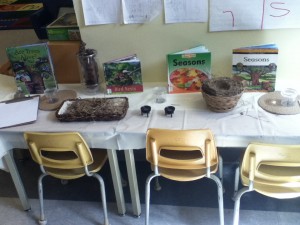 We are currently working on growth and change as an inquiry focus. I have selected materials that we have found in nature as well as some science items like worms, frogs, chicken embryos, and grasshoppers for the children to examine. We have studied some of them using our KWL chart—becoming researchers and looking in books, and on the internet to answer our “I wonder” questions. Through this learning process, children have been exposed to several types of non-fiction books (we compared fiction and non-fiction), learned how to journal their observations with adult support, and have drawn diagrams with labels. The materials are left for them to explore during our learning block of play. As children explore I will often place myself into the space to hear their conversations, to encourage them to record what they see, and to ask open-ended questions about their thoughts or to extend their learning. Next we will be adding our Butterflies to the collection!
We are currently working on growth and change as an inquiry focus. I have selected materials that we have found in nature as well as some science items like worms, frogs, chicken embryos, and grasshoppers for the children to examine. We have studied some of them using our KWL chart—becoming researchers and looking in books, and on the internet to answer our “I wonder” questions. Through this learning process, children have been exposed to several types of non-fiction books (we compared fiction and non-fiction), learned how to journal their observations with adult support, and have drawn diagrams with labels. The materials are left for them to explore during our learning block of play. As children explore I will often place myself into the space to hear their conversations, to encourage them to record what they see, and to ask open-ended questions about their thoughts or to extend their learning. Next we will be adding our Butterflies to the collection!
In continuation with our beautiful stuff project, the children used real wood piece to create home, buildings, bridges and other various structures. The children created, draw their designs, labelled some parts, glued and painted their designs. It was a great and fun experience.
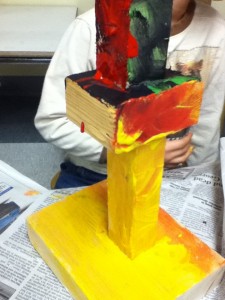
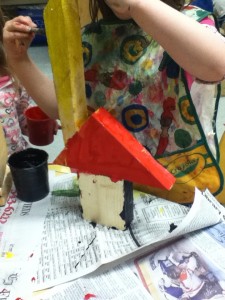
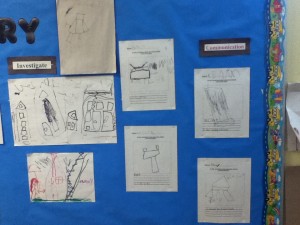

 This student independently drew a picture of his neighbourhood when we were writing in our journals. He carefully selected shapes that are parts of a building, told me about the buildings-some stores and houses and added stairs that go to the bed on the top floor (blueprints show stairs!).
This student independently drew a picture of his neighbourhood when we were writing in our journals. He carefully selected shapes that are parts of a building, told me about the buildings-some stores and houses and added stairs that go to the bed on the top floor (blueprints show stairs!).
Here is a great, free resource entitled Natural Curiosity http://naturalcuriosity.ca/pdf/NaturalCuriosityManual.pdf
It gives details and research round building inquiry from nature and the world around children! The full website is http://naturalcuriosity.ca/
This is a great chart that shows how a read aloud (high support) is used to eventually become an Independent Resource (low support) for students to read on their own or at home.
One is done with a poem and the other is a Big Book that is repetative, and is simple to follow (level C). I just finished this book-I Went Walking with my class and they loved it. Here is a 5 day plan for the book. http://www.eworkshop.on.ca/edu/pdf/Mod08_WP_k_l_went_walking.pdf


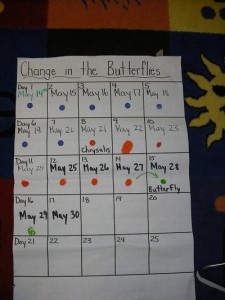
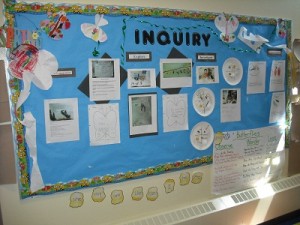

Recent Comments